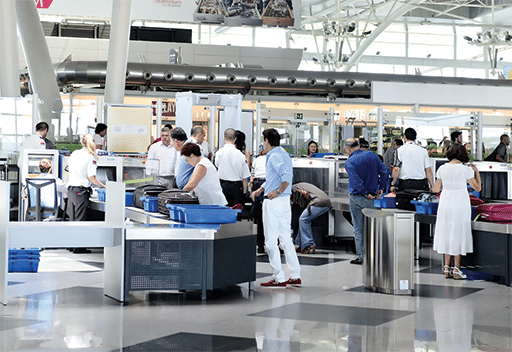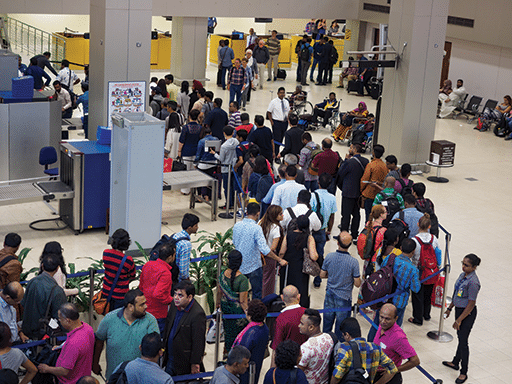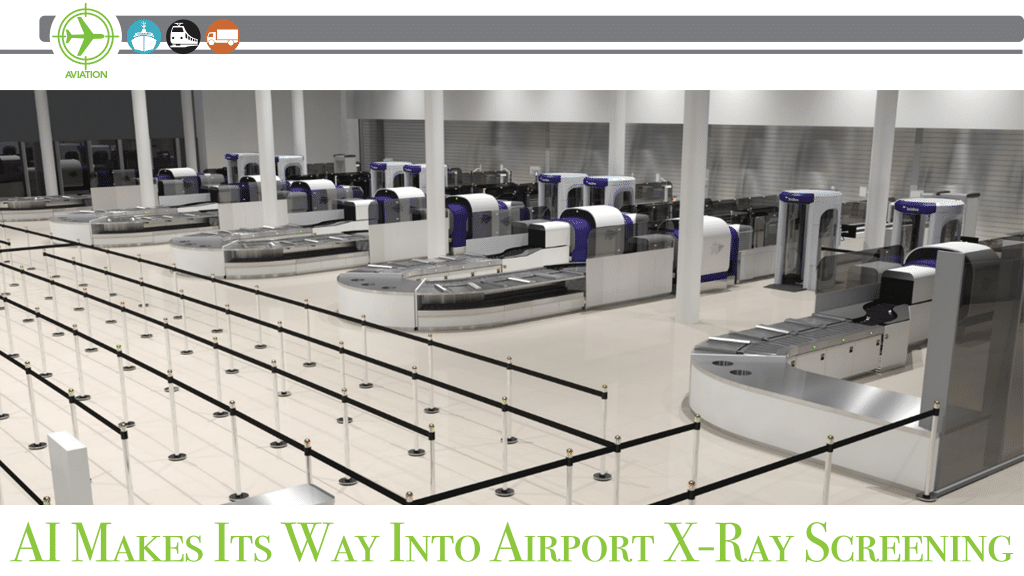The artificial intelligence (AI) revolution has made its way into airport X-ray passenger screening systems. By incorporating AI and machine learning (ML) into the process, X-ray screening equipment manufacturers are improving the accuracy, reliability and usefulness of this defense against terrorists.
“The use of artificial intelligence and machine learning (AI/ML) and third-party algorithms to enhance threat detection is on the rise,” said Nicholas E. Ortyl, Leidos’ chief engineer of security solutions. “We use AI/ML in our threat detection algorithms and have begun integrating third-party algorithms in certain use cases.”
A case in point: “Automated prohibited item detection systems (APIDS) are an innovation with much potential for strengthening security and improving efficiency,” said Dr. Yanik Sterchi, a senior research scientist with the Center for Adaptive Security Research and Applications (CASRA). “APIDS capitalize on the advances in AI to detect a variety of prohibited items in X-ray or CT images of passenger baggage.”
How AI Algorithms Assist Passenger X-Ray Screening
To put matters into context, let’s begin by defining what AI algorithms actually are. According to TechTarget.com, “AI algorithms are a set of instructions or rules that enable machines to learn, analyze data and make decisions based on that knowledge. These algorithms can perform tasks that would typically require human intelligence, such as recognizing patterns, understanding natural language, problem solving and decision making.”
Next, let’s narrow our focus to passenger X-ray screening. “For the development of AI algorithms that detect threats, thousands of images are needed that contain a threat,” Sterchi said. “These images together with the location of the threats are fed to a deep neural network, which is then trained to detect the threats. This works similar to how AI can detect objects in photos (e.g., cars, dogs).”
In the realm of passenger screening, “Both conventional X-ray and CT scanners are using increasingly sophisticated AI algorithms to help them ‘recognize’ threats, developed by crunching thousands of X-ray images to build a suite of identifiable traits for objects based on shape, texture, color and density,” said Richard Thompson, vice president of marketing with Smiths Detection. “This approach builds effective screening profiles for dangerous contraband items such as weapons, explosives, and indeed, narcotics.”
It is AI’s ability to process huge volumes of data extremely quickly that makes it so useful in passenger X-ray screening. This capacity allows AI-enabled systems to ‘crunch’ and compare the thousands of images mentioned by Thompson to identify potential threats in a speedy manner.
“At Leidos, we employ deep learning AI methods to examine hidden relationships within the test dataset, aiming to form meaningful associations between threats and the features and shapes of objects,” Ortyl said. “Additionally, advances in dataset generation help ensure these algorithms are built using high quality imagery with precise threat labeling. This approach minimizes the ambiguity between true threats and non-threats.”
This level of fast, deep analysis is something that humans simply cannot do on their own. We’re not alone in this deficiency: “Traditional detection methods typically rely on comparing detected objects against a collection of images and parameters,” said Ortyl. “However, when presented with rotated or oddly positioned detections, these methods could potentially lead to false negatives and false positives due to inherent limitations.”

Maximizing Accuracy by Combining Real-time and Synthetic Data
To analyze data from passenger X-rays in meaningful, insightful and actionable ways, AI algorithms typically draw upon a combination of real-time operational and synthetic data. Real-time operational data refers to the information collected by X-ray systems as they screen passengers. Synthetic data refers to artificially generated data that mimics real-world data created by algorithms or simulations. It resembles real-time data in terms of statistical and physical properties, distribution, and patterns, but it is entirely generated by computer and mathematical models rather than data captured during actual passenger screening.
The reason this combination is being applied in AI-enabled X-ray screening is because synthetic data can be used to augment limited real-world datasets, making them larger and more diverse. These expanded datasets then assist in training more robust and generalized ML (machine learning) assessment models for X-ray screening systems. In turn, this improved training results in more accurate AI-enabled screening in real life.
Combining real-time and synthetic data offers a further advantage to AI-enabled X-ray screening. In these cases where real-time data contains sensitive or private information that cannot be used for ML training, synthetic data can take its place to create surrogate datasets that preserve the statistical properties of the original data while supporting privacy. Other benefits of using synthetic data include lower cost and accessibility as collecting and labeling large amounts of real-world data can be time consuming, expensive, or even impractical.
Of course, generating high-quality synthetic data requires careful modeling and validation. Additionally, synthetic data may not fully capture the complexities and nuances present in real-time data. As a result, it should be used judiciously in conjunction with real data whenever possible.

Benefits and Limits of AI-Enabled X-Ray Analysis
The world’s terrorists are keeping up with the pace of technological change. To keep the flying public safe, passenger screening technology has to do likewise.
“Airports already leverage several threat detection technologies at checkpoints, including millimeter wave people scanners, CT-based or X-ray baggage scanners, and explosive trace detection devices,” Ortyl explained. “But these alone may not be sufficient to stay ahead of threat actors and minimize disruptions to passengers. So, to enhance security operations and support rapidly evolving threats, the integration of AI-based algorithms will likely be a necessity. When properly integrated with checkpoint systems, AI-based algorithms can significantly improve threat detection, reduce human errors in threat detection decisions, and lower false alarm rates from the systems themselves.”
A case in point: By automatically detecting a variety of threats, controlled and prohibited items without impacting the speed of the overall image evaluation, Smith Detection’s AI-enabled iCMORE object recognition software improves operational efficiency at airports. “It has proven to be effectively integrated into normal workflows without impacting the flow of people, bags and cargo,” noted Thompson. At the same time, “iCMORE’s additional detection capabilities provide invaluable support to all image analysts, reducing the burden in decision making, and are particularly helpful for less experienced operators. It is intuitive and easy to use, thus little or no training is required. The increase in operational efficiency also leads to a faster, more streamlined experience of passengers and visitors that have to pass the checkpoint.”
At the same time, today’s AI-enabled X-ray systems should be seen as providing informed support to human security screeners, rather than fully replacing them outright. “AI can assist the officers and increase their detection and improve efficiency,” said Sterchi. “However, the first generation of these AI algorithms cannot yet detect all kinds of threats, which means we must still rely on officers checking for other threats. Beyond that, the consistent performance of the algorithms is both their strength and weakness: they do not tire or get distracted. But if there is a threat they do not detect, they consistently do not detect it, which could be exploited.”
This brings us to a fact about AI that is often missed: massive as they may be, AI-enabled systems are still software systems. As such, they are only as effective as the human thinking that coded their programming. If the coding and data is limited and/or flawed, the same will be true of the AI’s conclusions that are based on it. This is an age-old truth of computer programming known as “Garbage In/Garbage Out.”
“AI-based algorithms are designed to identify patterns in data to create actionable, real-time insights,” Ortyl said. “But the accuracy, speed, and fairness of decisions made by AI-based algorithms are only as good as the quality of the training data and associated ground truth, a characteristic of Leidos’ Trusted Mission AI platform. So, while AI/ML excels in many aspects of image detection, it’s important to acknowledge that human expertise and intuition remain valuable, especially in tasks requiring context, subjective judgment, or ethical considerations.”

Training, Privacy and Other AI Challenges
The power of any AI-enabled system is its ability to “learn” through being exposed to vast amounts of relevant data. This exposure helps the AI to detect and record patterns, providing a basis for the system to accurately assess new data such as X-rays to detect prohibited objects and other threats.
This learning process is known as “training,” and it is the core of any good AI-enabled system. For instance, at Leidos, “Machine learning operations (MLOps) is a development methodology that aims to deploy reliable and efficient machine learning models in production environments,” said Ortyl. “Some of the steps we take include data augmentation to train the models, dataset verification to improve labeling of training data, image preprocessing to improve the fidelity, dataset collection with real human models, and before and after comparisons to predict real-world testing outcomes.”
Of course, using huge datasets derived from human subjects can lead to privacy concerns on the part of the flying public. Fortunately, “AI-driven algorithms prioritize privacy by design, minimizing the storage and retention of unnecessary data and adhering to strict data access controls,” Thompson said. “Furthermore, AI enables proactive threat detection while preserving individual privacy through techniques such as differential privacy, which aggregates and anonymizes data to prevent the identification of specific individuals. By integrating AI into passenger screening protocols, authorities can strike a delicate balance between security imperatives and privacy rights.”
“I do not necessarily see substantial privacy and data security issues regarding personal data when AI algorithms are employed in airport security,” said Sterchi. “The data collection and training of the AI typically happens in a separate step prior to the implementation of the AI system at the airport and afterwards it is not necessary to collect data from passengers. ”This being said, overall cybersecurity is a constant concern for AI-enabled X-ray screening systems, which is why proactive threat detection and protection is a must for system operators.

“In fact, deploying AI for passenger screening presents several challenges,” Ortyl said. “Data privacy and security are key considerations; the collection and protection of AI datasets from breaches and unauthorized access is a high priority. But there is a risk of inherent biases in AI systems, which could potentially lead to unfair treatment of certain passenger groups. Therefore, it’s important for AI algorithms to strive for high accuracy to minimize false positives and false negatives. In addition, AI systems are expected to comply with various national and international regulations, which can be a moving target as new privacy laws and testing guidelines are introduced.”
Other challenges of AI-enabled X-ray screening include integrating AI into existing proprietary systems, which can be complex and costly, plus achieving operational readiness to deploy, maintain and support AI datasets and the systems that use them. AI systems also need regular dataset updates and retraining to stay effective against evolving threats. In turn, this requires ongoing access to high-quality data and robust processes for updating the algorithms.
Worth noting: “The EU regulatory framework requires a recertification for each update that affects detection capability,” said Sterchi. “It will therefore be crucial to have quick recertification processes in place. In the short term, we will have to rely on security officers who are frequently trained for the detection of new and evolving threats.”
Bringing AI Into the Workplace
Even though they have been designed to be intuitive and user-friendly, AI-enabled passenger X-ray screening systems are quite a change for airport screeners accustomed to relying on their own eyes and brains alone. This is why training and transition programs are vital to ensuring their seamless adoption at airports.
“Training people to develop, deploy and support AI in passenger screening should be managed using several key approaches,” Ortyl noted. “At Leidos, our training programs now include fundamental concepts of AI and machine learning, helping security personnel understand how these technologies work and how they can enhance screening processes. This includes hands-on training with AI-based screening tools to understand and interpret the rationale behind AI decisions.”

Smiths Detection image.
“At Smiths Detection, we understand that providing the best equipment in the world is only part of the solution: effective training that empowers our customers is crucial,” said Thompson. “To do this we are transforming the way we train people through the use of AI. For instance, our new Virtual Training Center employs Adaptive Learning Technology to personalize every trainee’s learning pathway. It does this by continually monitoring and analyzing data relating to each trainee’s knowledge, skills and learning behavior. The data is then used to adapt the training content to meet individual needs and optimize learning outcomes. This comprehensive data-driven approach not only enhances a trainee’s skills but also contributes to their overall success.”
“CASRA is also developing training modules specifically for security officers working with AI,” Sterchi added. “These focus on learning how to decide whether an AI alarm is correct or not and on searching the bag for the threats that the AI algorithm cannot yet detect.”
Training frontline staff is just part of the process. To stay sharp, the people who manage X-ray screening programs should also undergo regular training on the latest advancements in AI and threat detection, engage in scenario-based training sessions with synthetic data and simulations on a continual basis, and promote collaborative knowledge sharing with others in their profession as well. “These steps will better equip personnel to work alongside AI systems and enhance the overall security and efficiency in passenger screening,” said Ortyl.
It’s also important to strive for transparency in AI models, so that their decision-making processes are understandable and justifiable to their human operators. The reason: Lack of transparency can lead to mistrust and difficulty in justifying AI decisions, especially in cases of false positives or negatives. This is why it is crucial for security personnel to understand how and why the AI reached the conclusions that they are expected to act upon.
“With regard to security officers, our research shows that the deployment of AI for X-ray cabin baggage screening changes their work considerably,” Sterchi said. “As they are expected to resolve the alarms of the AI system, they need a solid understanding of its capabilities and limitations.”

What’s Coming Next
The advances offered by AI-enabled passenger X-ray screening are transforming the very nature of airport security, and bringing it into the 21st century.
So, what is coming next? Well, how about using this same technology to check everyone coming into airport facilities? After all, “We often see airline and retail employees accessing terminals through the same checkpoints as passengers, but hundreds of other personnel working across the airport don’t undergo the same level of entry screening,” said Ortyl. “To bolster public confidence and protect the travelers, airport personnel and the airport infrastructure itself, it is essential to deploy advanced screening practices across the board. Hence applying the same AI-enabled X-ray security screening protocols used for passengers to every individual and their belongings before accessing secure areas of the terminal, where important functions like maintenance, baggage handling and airside fueling occur, is crucial. This is why we expect to see more airports move in this direction and have aligned our capabilities to support this operational shift.”

That’s not all: “The most obvious way forward with regards to automatic object recognition is to add further dangerous goods, prohibited items and other objects to the target recognition list,” Thompson said. “As well, while current AI algorithms are based on 2D images (even if run on CT systems), the development of true volumetric object detection will be a game changer with the growing use of CT-based systems for cabin baggage, hold baggage and freight. Open architecture approaches that enable the sharing of image data and the integration of third-party algorithms can certainly also pave the way to a more secure airport network if, and only if, the industry pulls together a common framework to ensure open architecture platforms operate safely and compliantly.”
“With regard to AI in X-ray cabin baggage screening, we can certainly expect that these algorithms will improve over the next few years,” said Sterchi. “I would therefore expect that security officers will no longer have to inspect all X-ray images. Instead, they will focus on the more difficult cases and APIDS’ alarm resolutions. Moreover, the screeners could also have a role for the continuous improvement of the AI systems. After all, a decrease in more easy tasks and increase in difficult tasks that require well-designed training to achieve the necessary expertise has been observed in many industries where automation was introduced.”

“The way forward is increased collaboration and constructive engagement not only between suppliers, but between suppliers, airports and regulators,” Thompson concluded. “Only through working more closely together will the industry realize the opportunity for a more integrated, data-driven and ultimately secure future.”
The bottom line: AI-enabled passenger X-ray screening is a major step forward for the airport security sector, and one that represents real progress in the fight against terrorists and others who want to violate airport security. As such, airports large and small should consider adding AI to their security arsenals, because this technology can make a real difference.
